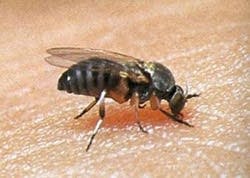Gnats are awful this spring, but it might get better soon
Go Deeper.
Create an account or log in to save stories.
Like this?
Thanks for liking this story! We have added it to a list of your favorite stories.

If you've spent much time outdoors this spring, you probably know the feeling of a gnat bite.
It starts when a female biting gnat cuts a small chunk of skin from its victim. Then the small black fly feeds on the blood that seeps into the newly formed hole.
"They also have an anticoagulant that they dribble into that little hole they've made, and so that's what causes the really intense reaction," said Mike McLean of the Metropolitan Mosquito Control District.
While these gnats don't carry any diseases that can transmit to humans, Minnesotans have experienced the annoyance of an especially large gnat population this season.
Turn Up Your Support
MPR News helps you turn down the noise and build shared understanding. Turn up your support for this public resource and keep trusted journalism accessible to all.
Most people would simply call them "gnats." But Minnesota is home to four kinds of biting gnats, or black flies. This year's most prevalent pest is known as the buffalo gnat.
They're closely related to mosquitoes, McLean said, "but they're tougher."
Mosquito repellent keeps gnats at bay, too. But miss a spot of skin and they aren't as forgiving as mosquitoes.
"Black flies are a little bit more aggressive and they'll go for those uncovered parts of your body," McLean said. "If you miss a spot with the repellent there, they're likely to find it."
Minnesota's clean and abundant water is good for buffalo gnats. Their larvae hatches in it and they filter feed from water, too.
Plus, widespread flooding across Minnesota has made treatment difficult or impossible in many areas.
The Metropolitan Mosquito Control District usually treats Twin Cities-area streams and rivers with Bti, a naturally occurring bacterium from the soil.
But this year, McLean said water levels are too high to make Bti effective. The flooding creates practical challenges, too.
"It really becomes a safety issue," McLean said. "We can't get our boats out there in some of the places where we ordinarily do the treatments."
Relief on the horizon?
McLean noted that this past weekend, and this season in general, have been especially bad when it comes to gnats.
However, he said Minnesotans could see some relief from the pests even in the next few days.
Gnats have a short life cycle. Even a windy day can help clear them from the air, McLean said.
Plus, the MMCD has been able to start some treatments. McLean said workers already did some treatments on the Mississippi River at the Coon Rapids Dam.
For now, keep the bug spray and vanilla handy.
Correction (June 10, 2019): In an earlier version of this story, Mike McLean's name was misspelled.



